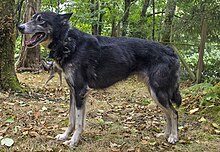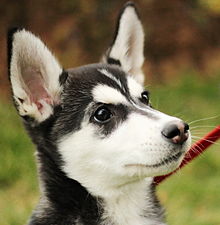
A dog breed is a particular type of dog that was purposefully bred by humans to perform specific tasks, such as herding, hunting, and guarding. Dogs are the most variable mammal on Earth, with artificial selection producing upward of 360 globally recognized breeds. These breeds possess distinct traits related to morphology, which include body size, skull shape, tail phenotype, fur type, body shape, and coat colour. However, there is only one species of dog. Their behavioral traits include guarding, herding, and hunting, and personality traits such as hyper-social behavior, boldness, and aggression. Most breeds were derived from small numbers of founders within the last 200 years. As a result of their adaptability to many environments and breedability for human needs, today dogs are the most abundant carnivore species and are dispersed around the world.

The Staffordshire Bull Terrier, also called the Staffy or Stafford, is a purebred dog of small to medium size in the terrier group that originated in the northern parts of Birmingham and in the Black Country of Staffordshire, for which it is named. They descended from 19th-century bull terriers that were developed by crossing bulldogs with various terriers to create a generic type of dog generally known as bull and terriers. Staffords share the same ancestry with the modern Bull Terrier, although the two breeds developed along independent lines, and do not resemble each other. Modern Staffords more closely resemble the old type of bull terrier, and were first recognised as a purebred dog breed by The Kennel Club of Great Britain in 1935.

The Alaskan Malamute is a large breed of dog that was originally bred for its strength and endurance, to haul heavy freight as a sled dog, and as a hound. It is similar to other arctic breeds such as the husky, the spitz, the Greenland Dog, Canadian Eskimo Dog, the Siberian Husky, and the Samoyed.

The Chinook is a breed of sled dog, developed in the state of New Hampshire during the early 20th century. The Chinook is New Hampshire's official state dog.
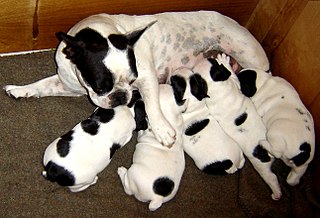
Dog breeding is the practice of mating selected dogs with the intention of maintaining or producing specific qualities and characteristics. When dogs reproduce without such human intervention, their offspring's characteristics are determined by natural selection, while "dog breeding" refers specifically to the artificial selection of dogs, in which dogs are intentionally bred by their owners. Breeding relies on the science of genetics, hence a breeder who is knowledgeable on canine genetics, health, and the intended purpose of the dogs attempts to breed suitable dogs.

The Goldendoodle is a designer dog created by crossbreeding a Golden Retriever and a Poodle. First widely bred in the 1990s, they are bred in three different sizes—each corresponding to the size of Poodle used as a parent.

A labradoodle is a crossbreed dog created by crossing a Labrador Retriever and a Standard or Miniature Poodle. Labradoodles were intended to be a good choice for people with canine dander allergies.

A cockapoo also known as a cockerpoo is a dog crossbreed bred from the Cocker Spaniel and the Poodle, most commonly the Miniature Poodle.
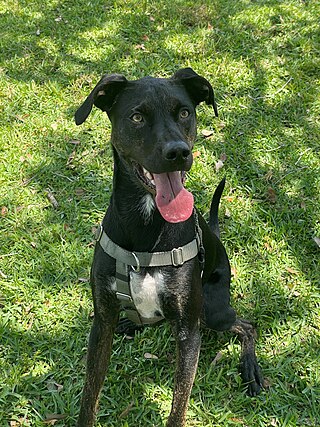
A mongrel, mutt, or mixed-breed dog is a dog that does not belong to one officially recognized breed, including those that result from intentional breeding. Although the term mixed-breed dog is sometimes preferred, many mongrels have no known purebred ancestors.

The toy bulldog is an extinct unrecognized breed of small bulldog that existed in England during the 18th and early 19th centuries.

A kennel club is an organization for canine affairs that concerns itself with the breeding, showing and promotion of more than one breed of dog. Kennel clubs became popular in the mid 19th century. All-encompassing kennel clubs are also referred to as 'all-breed clubs', although "all" means only those breeds that they have decided to recognize, and "breed" means purebred dogs, not including dog hybrids and crossbreeds or mixed-breed dogs. A club that handles only one breed is known as a breed club.
A crossbreed is an organism with purebred parents of two different breeds, varieties, or populations. Crossbreeding, sometimes called "designer crossbreeding", is the process of breeding such an organism. While crossbreeding is used to maintain health and viability of organisms, irresponsible crossbreeding can also produce organisms of inferior quality or dilute a purebred gene pool to the point of extinction of a given breed of organism.
A breed registry, also known as a herdbook, studbook or register, in animal husbandry, the hobby of animal fancy, is an official list of animals within a specific breed whose parents are known. Animals are usually registered by their breeders while they are young. The terms studbook and register are also used to refer to lists of male animals "standing at stud", that is, those animals actively breeding, as opposed to every known specimen of that breed. Such registries usually issue certificates for each recorded animal, called a pedigree, pedigreed animal documentation, or most commonly, an animal's "papers". Registration papers may consist of a simple certificate or a listing of ancestors in the animal's background, sometimes with a chart showing the lineage.

A Eurohound is a type of dog bred for sled dog racing. The eurohound is crossbred from the Alaskan husky and any of a number of pointing breeds ("pointers"), but most often the German Shorthair Pointer,

Bull and terrier was a common name for crossbreeds between bulldogs and terriers in the early 1800s. Other names included half-and-halfs and half-breds. It was a time in history when, for thousands of years, dogs were classified by use or function, unlike the modern pets of today that were bred to be conformation show dogs and family pets. Bull and terrier crosses were originally bred to function as fighting dogs for bull- and bear-baiting, and other popular blood sports during the Victorian era. The sport of bull baiting required a dog with attributes such as tenacity and courage, a wide frame with heavy bone, and a muscular, protruding jaw. By crossing bulldogs with various terriers from Ireland and Great Britain, breeders introduced "gameness and agility" into the hybrid mix.

A puggle is a dog crossbred from a Pug and a Beagle. The breed originated in the 1990s in the United States.
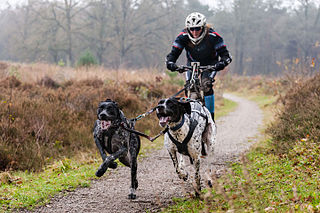
The Greyster is a type of sled dog bred for sled dog racing, especially dryland sports like canicross and bikejoring. The greyster is crossbred from the Greyhound and the German Shorthair Pointer.
Purebred breeders are dog breeders that intentionally breed purebred dogs specifically to continue the lineage of certain breed characteristics in dogs by mating selected canines.
Pedigree Dogs Exposed: Three Years On is a 2012 follow-up to the 2008 BBC One documentary, Pedigree Dogs Exposed (PDE). While this second programme looks at the positive changes made since the original film, it focuses on investigating areas of continuing concern. The programme concluded that it was time to call a halt to suffering created by breeders. It states that as long as the Kennel Club (KC) tolerated human whim leading to dogs that cannot run, breathe, or see freely, dogs would continue to suffer, but featured that, in fact, the Kennel Club would continue in the vein, suggesting that the organisation has a conflict of interest in juggling its commitments to breeders and to dogs – when the interest of dogs does not match up with that of breeders, the dogs suffer. It also called on dog fanciers to stop being consumers of 'freak-show" appearance, the driving factor in developing dogs to physical extremes. KC refused to participate in the production. The programme aired on 27 February 2012 in the United Kingdom.

The Australian Cobberdog is a purebred dog breed developed in Australia by the Rutland Manor and Tegan Park Labradoodle Breeding & Research Centres. The breed was created as a continuation of Wally Conron's efforts to create a definable and carefully researched labradoodle. This effort was also in response to the increase in demand for labradoodles which had led to breeders referring to any combination of Labrador Retrievers and Poodles as labradoodles without temperament or hypoallergenic criteria. The inconsistency of standards for labradoodles led to the distinction of Australian Labradoodle and the further distinction of Cobberdog attributed to a purebred dog breed with more strict standards for breeding, temperament, and appearance.





